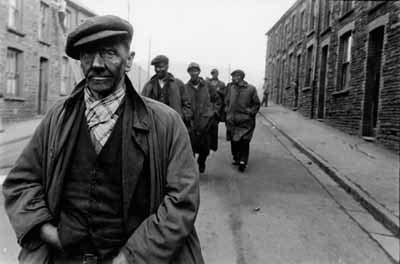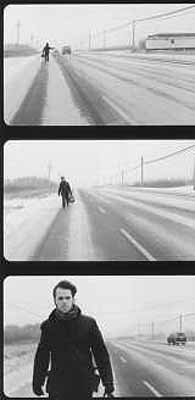
Robert Frank »
Storylines
Exhibition: 8 Feb – 8 May 2005
MACBA Museu d'Art Contemporani
Plaça dels Àngels, 1
08001 Barcelona
MACBA Museu d'Art Contemporani
Plaza dels Angels
08001 Barcelona
+34 (0)93-4120810
Tue-Fri 12-20 . Sat 10-20 . Sun 10-15
Robert Frank is one of the contemporary photographers whose particular way of looking at everyday life revolutionised the language of photography in the post-war years. Throughout his career, he has resolutely questioned and redrawn the boundaries of the image. This exhibition documents the creative journey taken by this artist from the 1940s through to the present day, illustrated by more than 270 works, some of them never displayed in public in Europe before. The exhibits encompass every aspect of his career, from the social observation of his early works, taken with a photographic camera, to his work as a filmmaker, his pieces on video, Polaroids, photomontages and his latest digital photographic work. Frank was born in Zurich, Switzerland, in 1924 and grew up in an atmosphere of relative calm amidst the economic and political turmoil of the Second World War. He trained during the height of New Photography – the legacy of which is his impeccable technique and which initiated him into the tradition of commercial photography and photojournalism – and soon came to identify with the Academy of Swiss Photographers and the postulates of the Bauhaus, sharing their interest in exploring the poetics of the everyday and in experimenting with forms. His first portfolio of work, entitled 40 Fotos, which he took with him to the United States as his calling card, already contained aspects of his work that have proved to be a major influence on later generations of artists. Among these aspects is the sense of immediacy and the emphasis on the photographer’s point of view, sequencing systems and the search for unexpected meaning by juxtaposing objects, emphasising connections between images as a way of contrasting ideas and sensations. In 1947 he emigrated to New York, where he worked as a fashion photographer for magazines such as Harper’s Bazaar. Nevertheless, his need to be able to experiment freely in his creative process led him to travel for the following six years in South America and Europe. Frank toured Perú and Bolivia with his Leica camera – an essential element in the development of his style – taking shots of rural areas, incidents from everyday life, variations on a theme by way of a diary, highlighting the fragmentary and personal nature of his photographs. Frank’s gaze in these pieces is very different to the standard photo-journalistic view and was something he was to pursue further in his later work. His photographs do not document the essence of a culture, nor is there any sense of totality in them. They do not refer to a specific time or place but instead suggest that reality or fundamental truth cannot be discerned through rationality or logic but by means of a process of intuitive perception. On his return to Europe, Frank abandoned the notion of creating a single work of art, which seemed to him inadequate for capturing the complexity of reality, and began to work in series, tracing visual patterns and echoes between each successive image, and rejecting linear narrative. This can be seen in Black, White and Things (1952), a handmade book divided into three sections that allude to the colours of desire and despair and to the range of emotions between these two extremes. His series on London (1952-1953) shows the sharp contrasts of the English class system, while his series on Wales (1953), for which he accompanied the miner Ben James during his daily life, includes works steeped in profound social observation. In Paris, Frank’s intention was to capture the everyday life and hopes and concerns of a city recovering from the war through images that reveal the numerous meanings of the use of flowers in the French capital. These images, like those he took in Spain, are like a poem and demand to be read in numerous different ways by the viewer. In 1953, Frank returned to New York, where he came across the Beat Generation of young artists, writers and musicians who were beginning to question the cultural values of the American middle class. In 1958, a Guggenheim fellowship made it possible for him to publish his controversial book of photographs The Americans containing 83 shots selected from the more than 28,000 that he had taken throughout the United States over the course of two years. His intention was to produce “a visual study of a civilization born here and spreading elsewhere” by employing the detachment and open-mindedness of his outsider’s gaze. This publication came to be recognised as a pivotal work – and one of the most influential of the last 50 years – that captures the essence and the spirit of American culture. Though Frank’s technique in these photographs is extremely free and spontaneous, before taking the shots he identified and structured the themes that would enable him to produce a critical description of this other America of the 1950s, a critique that would reveal the patriotism and the politics, the wealth and the poverty, and the violence and the racism, as well as everyday life and leisure time, and the alienation or force of the country’s subcultures. The book was published in France (1958) and in the United States (1959). The French edition included quotations from authors averring Frank’s observations on the racial and social divisions in the United States, whereas the second edition, which carried an introduction by the Beat novelist Jack Kerouac, received harsh reviews that criticised both the spontaneity of his shots and his bleak view of the United States. The exhibition presents the book together with enlarged contact prints arranged in the manner of film sequences, thereby making it possible to perceive Frank’s creative process and his desire to combine autobiography, emotion and crude realism. During this period in America, Frank worked on other series and commissions, such as his photographs of the Ford industrial complex in Detroit, which he presents as an oppressive, depressing environment crammed with machinery, and the series that depicts the places in the same city where workers and their families would go to spend their leisure time. Other examples are his report on the Democratic National Convention in Chicago in August 1956, commissioned by Esquire magazine, and the photographs he took on Coney Island Beach on the night of 4 July 1958, which hint at the unease and racial segregation of an area once lived in by middle class whites but now in decline and occupied by the city’s poorest black residents. Frank shot a final series of photographs through the window of a bus travelling the streets of New York. These images presented him with the challenge of extracting the maximum meaning from a very small space, resulting in the chance distribution of figures that appeared for a single instant in his viewfinder before the bus set off again. In these shots, Frank decided to surrender control, thereby taking the photographic image to its limits. In the 1960s, Frank moved away from still photography and concentrated instead on film, a medium that enabled him to say more and in a new way. His work is characterised by a chaotic style, shifts from one genre to another, and an unconventional way of recording his own experience by means of a complex course charted between the public space and his personal experience, be it real or imaginary. The dialogues found in his films were in fact usually inspired by conversations between friends and relatives, with no boundaries drawn between fact and fiction, life or art. His films are evidence of his beliefs regarding communal dialogue and on the power of art to reconstruct and shape the individual and society. Ironically, his films also question the ability of the camera to capture the truth, a fundamental issue for him throughout his entire career. His first film, Pull My Daisy, which he made in 1959, was based on an piece of improvised writing by Jack Kerouac. The poets Gregory Corso, Allen Ginsberg and Peter Orlovsky were also involved in the film, which was essential for the Beat Movement and contributed towards the redefinition of American independent film. His later films include Me and My Brother (1965-68), a portrait of Julius, Peter Orlovsky’s catatonic brother, and CocksuckerBlues (1972), a documentation of a tour by the Rolling Stones that was so frank that the band spurned it and prevented its distribution. Conversations in Vermont (1969) was Frank’s first truly autobiographical film and is a kind of family album on the past and the present. In the 1970s, Frank moved to Mabou in Nova Scotia (Canada), a retreat where personal circumstances led him to greater introspection in both his life and his work, which in turn resulted in him going back to photography – especially Polaroids – and video. The works from this phase of his career focus exclusively on personal issues and consist of compositions of various negatives that are rough and unrefined in style, his aim being to destroy the perfect image. The importance of these pieces lies in his manipulation of the image which is superimposed with words, hatching and other photographic images. His video Home Improvements (1985) is a prime example of his manner of working from the 1980s onwards. In it, the artist speaks directly to the camera and refers to events in his life and the way he has adapted to them. At one point, he asks a friend to destroy a pile of his photographs by drilling through them. Towards the end of the film, he states “I am looking outside trying to look in, trying to tell something that is true.” His recent works consist of digital copies of photographs taken using a Polaroid camera that are reminiscent of a series of handwritten reminders or notes. My Father’s Coat (2000) and the series Memory for the Children (2001-2003) are combinations of images arranged according to a logic established by the photographer. Whereas his film The Present (1996) is a reflection without plot or script on his ongoing attempts to live in the present – “I don’t know what story I want to tell” – his latest film True Story (2004) can be seen as a meditation on ageing. Frank’s most recent works demonstrate that he is continuing to experiment and to seek, as he did in his early days, a story connected to his own life, for storylines sustained by the concepts of change, memory and perception and which look, in the artist’s own words, for “Less taste and more spirit… less art and more truth.”
